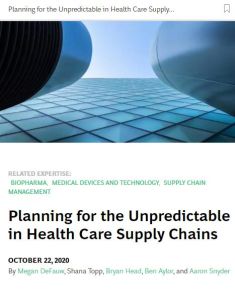Join getAbstract to access the summary!

Join getAbstract to access the summary!
Megan DeFauw, Shana Topp, Bryan Head, Ben Aylor and Aaron Snyder
Planning for the Unpredictable in Health Care Supply Chains
Boston Consulting Group, 2020
What's inside?
Remember when they said NOT to wear masks?
Recommendation
The public was concerned about toilet paper scarcity, but medtech and biopharma companies had other shortages in mind. Would there be enough masks and gloves and other medical supplies to go around? What if manufacturers shut down or suppliers became inaccessible? The COVID-19 pandemic exposed fragility in the global supply chain, but medical supply vulnerabilities were among the scariest revelations of the pandemic. Biopharma and medtech companies can assess their supply chain resiliency using this report from the Boston Consulting Group.
Summary
About the Authors
Megan DeFauw, Shana Topp, Bryan Head, Ben Aylor and Aaron Snyder are professionals with the Boston Consulting Group.

















Comment on this summary